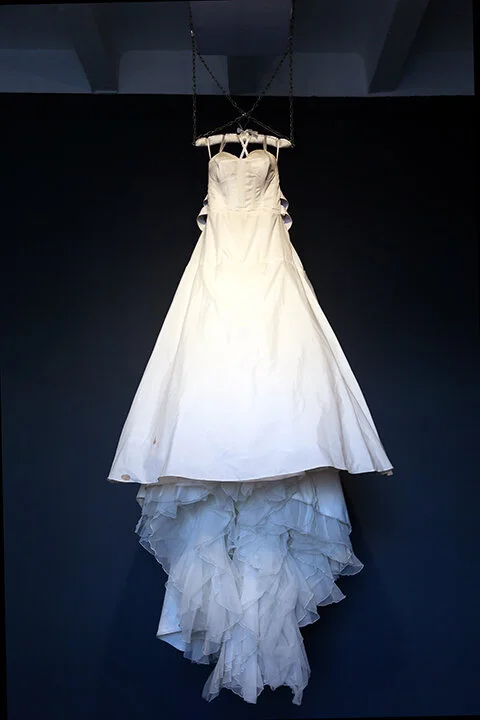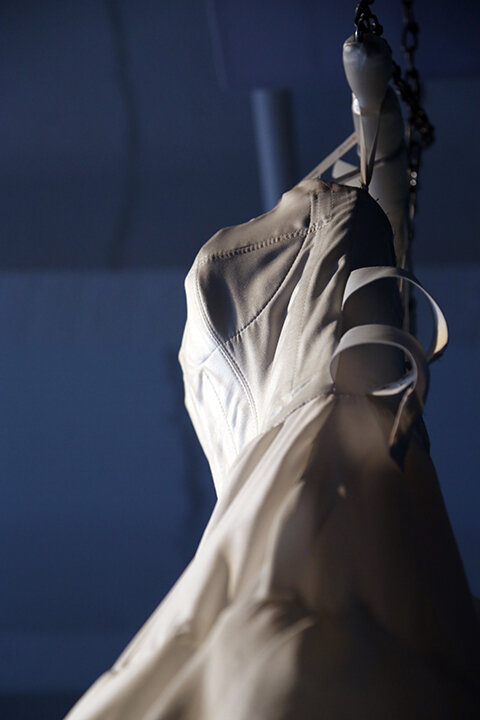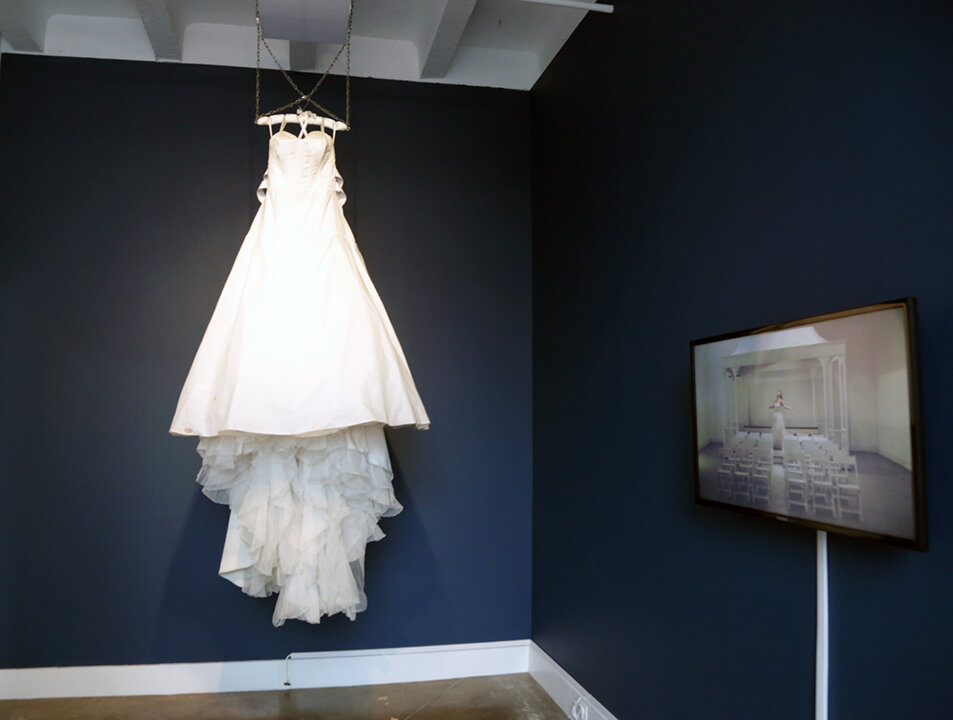blood sweat & tears, 2012
interactive sculpture with stained wedding dress, chains, silk hanger, hypersonic sound emitter, vibration sensors, 8 audio performance tracks | 95" x 44" x 38" (dress), installed dimensions variable



Singular private pleasures activated by the touch of the public; entering underneath the inside-out, blood, sweat, and tear-stained wedding dress, the viewer activates and becomes complicit in the expression of the artist’s recorded self-induced orgasms.
Jessica Beck, Art Historian and Programs and Programs Associate at the Hirshhorn Museum and Sculpture Garden on Blood, Sweat, and Tears:
"For this work the artist refashioned the wedding dress that she wore for the Save The Date performance to explore the body as trace and to challenge our accepted notions of female desire. The dress is hung from the ceiling by what the artist calls an 'armature of contrasts: roughshod chains (similar to the restraints used for outdoor dog runs) and a delicate silk hanger.' The symbolic garb is stained visibly with blood from dancing, sweat from nerves and celebration, and tears from the joy and pain of that emotional day. The dress brings to mind Robert Gober’s controversial 1989 work Wedding gown, Cat litter, and Hanging man / Sleeping man, which juxtaposed a wedding dress with conflicting social and racial images. In Gober’s work the wedding dress stands hollow, almost miraculous, as a symbol of virginity. Bright lights illuminate the satin finish of Gober’s work making it glow in a way very different from the dress in Blood, Sweat and Tears. Cornelius takes this symbolism of purity and virginity socially ascribed to the 'white wedding' dress and turns it on its head, quite literally, by displaying the dress inside out, a gesture that is at once aggressive as it is vulnerable.
Sex, pleasure, and desire in this work are complicated in the public space of the gallery as the viewer is asked to enter into an unfamiliar, slightly uncomfortable space. Although devoid of a body, the wedding dress is not empty; activated by the viewer, it fills with sound. Invited to enter under the dress and stand inside the layers of white taffeta, the viewer inhabits a space pregnant with the sound of a female panting, breathing and climaxing. Eight different recordings of the artist pleasuring herself are played one after the other as viewers enter the inner core of the dress. The number 8 holds personal significance for the artist when 'turned to its side represents infinity.' While each session reaches a full cycle of beginning and end, the artist is most interested in the 'transcendent, post-orgasmic state, the life after le petit mort.' Caught in a sense of surprise, the viewer is surrounded by layers of fabric heavy with the scent of a body and the sound of the artist’s climaxing breath. With the orgasmic soundtrack flooding the dress, the layers of fabric begin to look and feel like the folds and vulvar forms of Georgia O'Keeffe’s flower paintings.
The desire generated in this work is for the artist alone. Compared to Vito Acconci’s staged performance piece at the Sonnabend Gallery in 1972, Seedbed, where hidden under a wooden ramp the artist famously masturbated in response to the viewer’s footsteps above him, Cornelius’s arousal is self generated. Whereas the viewer was used as a source of excitement in Seedbed, here the viewer is invited only to listen to the pleasurable act. Pleasure in Blood, Sweat, & Tears is self generated and the viewer must confront their own discomfort with the subject of the piece. In this work the moral position of the viewer, who is given the opportunity to penetrate the boundaries of the factitious, absent body by entering the hanging dress, is challenged. Standing inside the dress, listening to the erotic breath of the artist, the viewer is forced to explore the limits of his/her own behavior. Furthermore, the very boundary between art and its audience—between art and life—is reduced and overtly challenged in this work."
